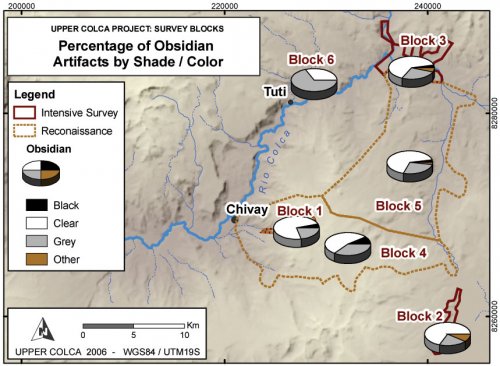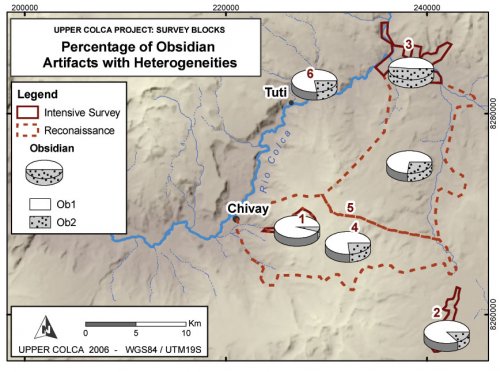Why quarry for obsidian when it can be found on the surface?
A quarry pit was located on the south side of Block 1 in the Maymeja area of the Chivay source. This quarry will be described below, as well as in Chapter 7 where the quarry pit is examined and the results are presented from a test unit placed in the debris pile associated with the pit.
(1) Larger nodules could be acquired through quarrying.
Energy was evidently expended in digging to extract obsidian at the quarry pit in Maymeja and the motivation behind this effort an important question. Looking at the general patterns over the entire study area is instructive because it reveals some general patterns that were counter to expectations of this research project. If the original nodules from the Block 1 area were of a larger size it may account for the quarrying activity observed in Maymeja.
|
Points and Tools |
Cores |
Simple Flakes |
Total |
|||||||
|
Block |
No. |
mLn |
sLn |
No. |
mLn |
sLn |
No. |
mLn |
sLn |
|
|
1 |
4 |
38.2 |
10.0 |
110 |
48.5 |
8.7 |
88 |
38.7 |
14.9 |
202.0 |
|
2 |
3 |
27.0 |
4.7 |
8 |
38.9 |
7.7 |
26 |
23.8 |
10.9 |
37.0 |
|
3 |
3 |
27.8 |
2.4 |
9 |
41.9 |
8.0 |
14 |
26.3 |
11.1 |
26.0 |
|
4 |
- |
- |
- |
33 |
41.6 |
7.5 |
34 |
34.9 |
12.2 |
67.0 |
|
5 |
1 |
28.0 |
- |
11 |
36.9 |
11.8 |
82 |
22.0 |
9.9 |
94.0 |
|
Total |
11 |
31.8 |
8.2 |
171 |
45.8 |
9.5 |
244 |
30.2 |
14.5 |
426.0 |
Table 6-6. Lengths of complete obsidian artifacts with > 30% cortex by survey block surface collections, showing means and standard deviations.
In Table 6-6 the length of cortical obsidian artifacts from surface collections from throughout the study region with a minimum threshold of 30% cortex are shown. It should be noted that tools and flakes must have 30% covering of dorsalcortex to qualify for this table, whereas cores need only have 30% cortex anywhere on the exterior surface to be included here.
The first indicator of differential activity in Block 1 is the sheer number of cortical cores in these surface collection data. Table 6-6 reveals that the mean size of cortical artifacts in all three technical classes is notably longer in Block 1, and that the second largest mean lengths are from Block 4, adjacent to the Maymeja area. The artifacts from Block 2 are surprisingly small considering that the Chivay source is only one day's travel from this location. The fact these cortical artifacts are small suggests that they did not have access to large starting nodules. Table 6-6 also shows that the cortical artifacts from Block 3 were slightly larger than one would expect considering that Blocks 5 and 2 are equidistant, if not closer, to the Maymeja area of the obsidian source than is Block 3.
(2) Obsidian from the quarry pit had more transparent coloration.
In the course of this research it was observed that there is variability in the transparency and color of culturally-modified obsidian throughout the study area and the spatial distribution is related to the appearance of natural obsidian in geological contexts. Chivay obsidian is renowned for its clarity and it is possible that material from one survey block had a greater frequency of transparency than did material from surrounding survey blocks. If clarity was a desirable characteristic of obsidian artifacts then the evidence may show a greater focus on production in areas where transparent obsidian was common. Much of the obsidian contained dark banding as well, and this banding was more visible with clear obsidian than when the obsidian matrix was a darker coloration.
Figure 6-2. Proportion of obsidian for four colors (shades) of glass, by count.
|
Black |
Clear |
Grey |
Other |
|||||
|
Block |
No. |
% |
No. |
% |
No. |
% |
No. |
% |
|
1 |
13 |
4.0 |
245 |
74.9 |
66 |
20.2 |
3.0 |
0.9 |
|
2 |
1 |
0.6 |
111 |
66.9 |
40 |
24.1 |
14.0 |
8.4 |
|
3 |
3 |
2.7 |
71 |
63.4 |
33 |
29.5 |
5.0 |
4.5 |
|
4 |
12 |
8.2 |
79 |
54.1 |
55 |
37.7 |
0.0 |
|
|
5 |
5 |
2.4 |
141 |
66.5 |
61 |
28.8 |
5.0 |
2.4 |
|
6 |
0.0 |
7 |
33.3 |
14 |
66.7 |
0.0 |
||
|
Total |
34 |
3.5 |
654 |
66.5 |
269 |
27.3 |
27.0 |
2.7 |
Table 6-7. Obsidian artifact color (shade) by survey block surface collections. Includes obsidian with bands and without bands.
As shown in Table 6-7, Block 1 indeed has a higher fraction of clear obsidian than other blocks in the survey. The high incidence of clear obsidian at Block 2 (67%) further suggests that whoever was quarrying and reducing obsidian at the A03-126 workshop in Block 1 was also associated with the settlements in Block 2, as there is no naturally occurring obsidian in Block 2. As Block 2 is on the direct transport route towards the Lake Titicaca Basin, this evidence suggests that some of the clear obsidian from Block 1 was being consumed in Block 2 en route to the larger consumption zone of the south-central Andean highland region and the Titicaca Basin where Chivay obsidian was purportedly prized for its clarity. It should be cautioned that the distinction between grey and clear obsidian appears to be correlated with thickness. That is, a "clear" artifact is more likely to be considered "grey" if it is thicker because it appears to be less transparent as a result of thickness.
(3) Block 1 had more homogeneous Ob1-type obsidian.
A further line of inquiry relates to the question of presence of heterogeneities in the obsidian. The Block 1 area with both the quarry pit, and the greatest abundance of large nodules, did not entirely consist of Ob1 homogenous obsidian. Investigating all the artifactual obsidian collected from surface contexts in the course of this project by survey block, a number of general patterns emerge.
Figure 6-3. Proportion of obsidian material as Ob1 and Ob2 (heterogeneities), by count.
|
Homogeneous: Ob1 |
Heterogeneous: Ob2 |
||||||
|
Block |
No. |
% |
m%Cortex |
No. |
% |
m % Cortex |
Total |
|
1 |
355 |
93.2 |
36.6 |
26 |
6.8 |
35.4 |
381 |
|
2 |
329 |
90.6 |
6.1 |
34 |
9.4 |
15.9 |
363 |
|
3 |
96 |
64.9 |
15.4 |
52 |
35.1 |
10.2 |
148 |
|
4 |
140 |
73.7 |
23.0 |
50 |
26.3 |
31.2 |
190 |
|
5 |
172 |
73.2 |
30.8 |
63 |
26.8 |
22.5 |
235 |
|
6 |
17 |
77.3 |
1.2 |
5 |
22.7 |
2.0 |
22 |
|
Total |
1109 |
82.8 |
22.6 |
230 |
17.2 |
21.7 |
1339 |
Table 6-8. Obsidian artifact material type by Survey Block surface collections.
Table 6-8 reveals that a small percentage of Ob2 material was actually found to have been used in Blocks 1 and 2, although the representation of Ob2 material was considerably higher in the other blocks in the survey. On the whole, Ob2 cores are decorticated to the same extent as Ob1 cores, although further upon exploration in Table 6-8) reveals that in Block 2 there appears to be a distinct preference for Ob1 obsidian as cores of this material have only 6% cortex while those of Ob2 have nearly 16% cortex. This is a pattern that might be expected, as the Ob2 obsidian has flaws that both negatively affect knapping quality and affect the visual appearance. However, the pattern is reversed in Blocks 3 and 5 where the Ob2 obsidian is decorticated to a greater extent than Ob1 material. There is a link between the color of the obsidian and the material quality because 45% of the grey obsidian is the Ob2 material, whereas for the other shades of obsidian the Ob2 ratios are smaller (10%-25%).
It was noted that in the Maymeja area of Block 1, unmodified obsidian nodules on the surface were often Ob2 material because they had small gas bubbles in them. Accordingly, it appears that some fraction of the obsidian that was knapped in the Maymeja area was made from this Ob2 surface material because it represented 6.8% of the collections from Block 1. The distribution of Ob1 and Ob2 material at the Chivay source will be further explored below prior to examining the results of the survey work in detail.

